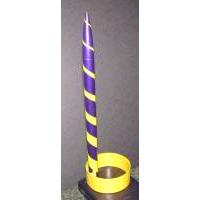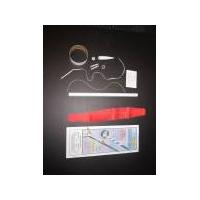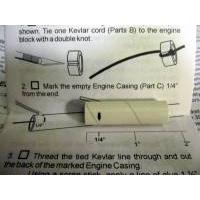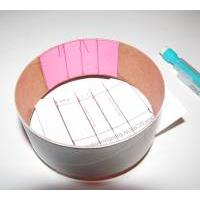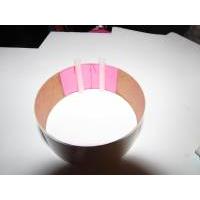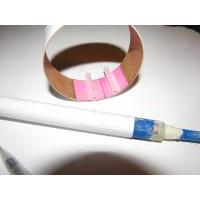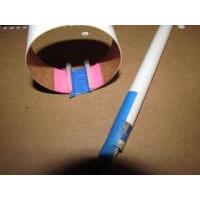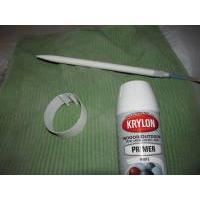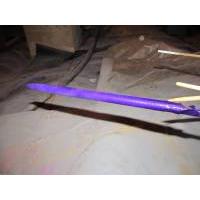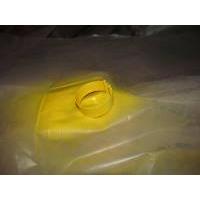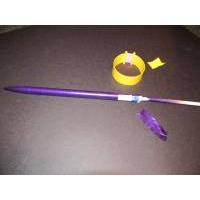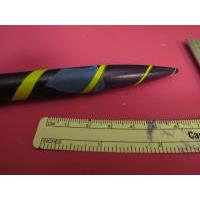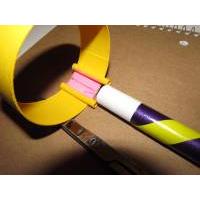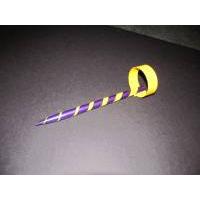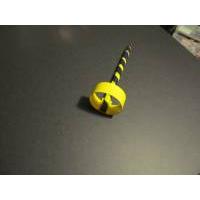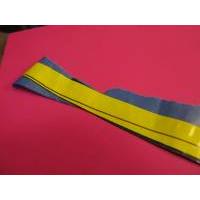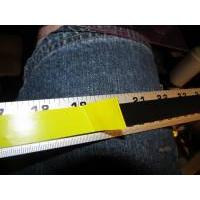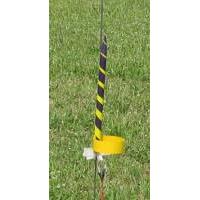| Overall Rating: | starstarstarstarstar |
| Published: | 2012-07-04 |
| Manufacturer: | Odd'l Rockets  |
| Style: | Ring/Tube/Cone Fin |
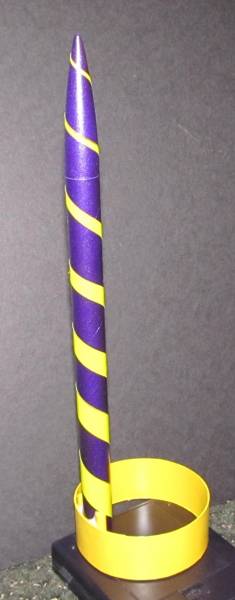
Brief
As opposed to typical 3FNC (Three Fins and a Nose Cone) this is 1FNC (One Fin and a Nose Cone) mini-engine sport rocket.
Components
Overall great components with one exception.
- BT-5 Body Tube-- Fairly tight tube spirals, I used two coats of primer to fill
- BT-5 Plastic Nose Ogive Nose Cone (two piece)
- BT-80 Ring Fin--- Also fairly tight tube spirals, filled with Primer
- Engine Block
- Short Length of Kevlar shock cord AND
- Short Length of GOOD elastic shock cord
- Marker Card for Reinforcement and Alignment (real plus!)
- Two Launch Lugs (you need both)
- Also provided an empty engine casing for engine block insertion (not pictured)
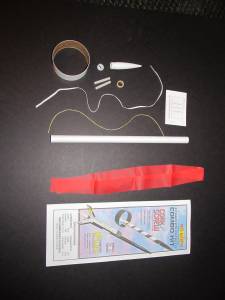
The weak spot was the streamer, one of which tore during the build, the other starting falling apart with one launch.
Construction
Because I decided to paint parts before completing construction, I combined construction and painting.
This is a Bruce Levison design. The design itself is really cool. Of course, standard wisdom is that the MINIMUM number of fins for stability is 3. Two fins won't work, and of course, one fin would be absurd. Unless, of course, it is a RING fin. However, if you have to ATTACH the ring fin with support struts, you could argue the struts are ALSO fins. so TECHNICALLY wouldn't be a one fin rocket. So how do you symmetrical attach the ring with no struts?
You don't. Mr. Levison attached the ring to the side of the rocket. Looks funky and looks like it shouldn't work, but it does. The design is stable, although it does cause a pronounced "corkscrew" flight pattern, hence the name. (Side note, discussion with one of the designers of this "kitted" version indicates that the degree of "corkscrewing" changes with the length of the rocket, this kitted version is specifically design to demonstrate the "corkscrew" flight characteristic. Reference http://modelrocketbuilding.blogspot.com/search/label/Corkscrew.
Enough about the original design. The guys that "kitted" this really did their homework on this one. Seriously, this kit goes together EASIER than your basic 3FNC beginner kit. For one thing--- NO BALSA. Nothing to sand, taper, round, or otherwise mess with. And with the Reinforcement plate and TWO launch lugs it is a CINCH to get the ring fin on straight (in my opinion EASIER than trying to get 3 fins straight on your typical beginner rocket)
The combined Kevlar/elastic shock cord is a nice touch. This gets attached to the engine block. The Kevlar presumably provides the burn resistance. The elastic provides some shock resistance. Also, not only do they provide you an empty engine casing, but on the instructions they even have a "quarter inch" mark for you.
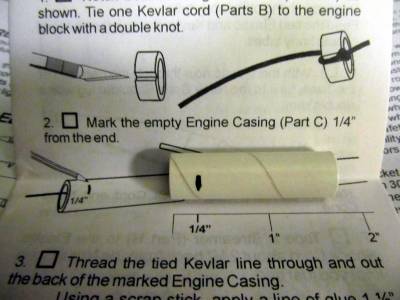
I attached the streamer to the elastic cord with tape as instructed. Didn't like the initial position, tried to loosen the tape and adjust it. Streamer material came apart just trying to adjust the tape. The kit actually comes as a combo with a "Powered FLIC Profile Shuttle." I cut the original streamer off, and used the streamer from the other kit.
The marker card and the TWO launch lugs are the key. For all practical purposes, you CANNOT put the marker card on wrong (check that, I guess you COULD put it on the outside. If you do this, strongly recommend you reconsider rocketry for something more compatible with your mechanical skills--- perhaps stamp collecting. This gets glued onto the inside of the BT-80 ring fin. Since it is exactly the WIDTH (front to back) of the ring fin, assuming you cut it out straight all you have to do is put it on the inside and line up the "long sides" with the edges of the ring fin (very easily done)
The marker shows you EXACTLY where to put the BT-50 body tube (rocket fuselage) and the launch lugs.
While the instructions were clear, I modified my approach because I chose a different paint scheme, AND because my scheme would be difficult to accomplish with masking after the build. So I elected to paint BEFORE attaching the ring fin to the fuselage. To do this however, I had to mask the "contact areas" before painting, as gluing painted surfaces guarantees a very weak joint, and in this case with only one fin (and that eccentrically places) this joint takes a lot of stress (which the kit designers anticipated and accounted for quite well.)
I attached the marking guide first, as per instructions. . Note on my pictures, I save original marking guides whenever possible, so I copied the Reinforcement Plate onto a piece of cardstock.
I decided to attach the launch lugs to the ring fin FIRST. Because of the relative small size of the lugs, it is pretty easy to get them exactly aligned with the markings. Personally, I think this actually would make the construction EASIER even if you didn't paint the parts separately, as in my opinion it is easier to get these two small lugs in perfect alignment than the relatively big body tube. Once you have the lugs in place, the body tube literally falls into perfect alignment.
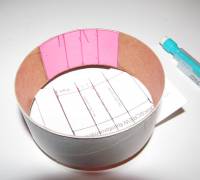
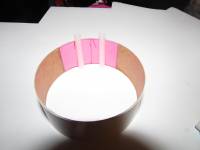
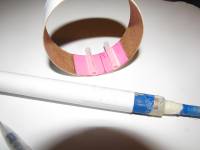
At this point, I dry-fitted the BT-5 tube to the ring fin. I marked the edges of the contact points on both the RingFin/Lug piece and on the body tube. I then MASKED the areas of contact on each piece.
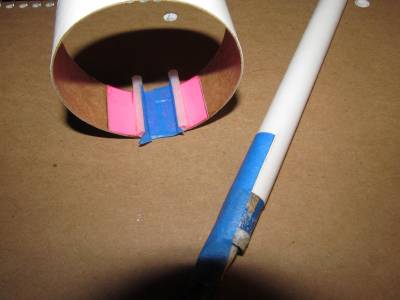
The tube spirals were pretty tight. I also felt my paint scheme would probably camouflage an residual spirals. So I used Krylon Primer to Prime and fill the spirals. The true craftsmn may consider fill and finish, but the tubes are high quality to begin with and I felt that was overkill.
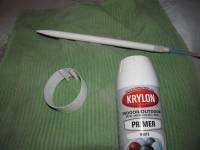
For a paint scheme, I thought I could come up with something a little more exciting than the black and white spiral on the cover picture. A really cool trick though was the use of electrical tape to create the tapered Barber Pole spiral. The tape has enough flexibility that you can get a true tight "spiral" that you can't get with any other tape I know of. And visiting the hardware store (great place to get rocket part ideas) I noticed they had OTHER colors than black. Hmmm...... How about bright yellow? Once I had the yellow tape, had to pick a background color. How about--- PURPLE!
Off to Hobby Lobby. Problem. The only cool purple they had was lacquer-based (Testors One Coat Lacquer Purple-Licious.) Wasn't sure how well this would go over the Krylon Primer. Did some quick research on Lacquer over Enamel, anyway, with multiple VERY light coats came out fine.
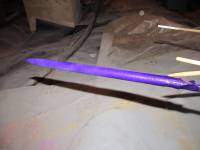
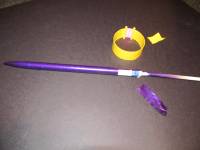
I like to hide the nose cone to body tube junctions on my rockets. The stock paint scheme instead emphasizes it with the different color. Besides, isn't a corkscrew supposed to taper to a point?
I put a piece of black tape on a metal ruler longer than the yellow tape. Then cut the long tapering "Barber Pole" with a hobby knife and another metal ruler. Was able to pull the yellow tape piece off the black tape.
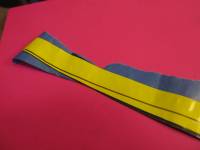
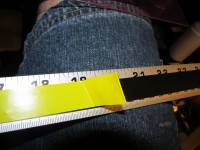
I put a piece of tape over the nose cone to body tube transition. Ran the tape from tip to tail, over the piece of tape (shield for nose cone edge). I was then able to cut the yellow tape over the transition, remove the shield, and re-affix the tape (spiral over nose cone edge).
I mated up the unmasked ring/kug part and the Body Tube part. Matched up perfectly as expected. Made attaching the body tube a snap. I did put a generous "internal fillet" in place as I knew I wouldn't have access to this area once the pieces were attached. (Heavy Fillet). Wiped away any excess glue. Did NOT put a fillet on the outside. (So far, it has held up quite well.)
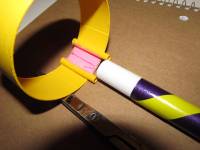
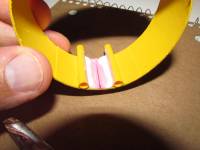
Flight
The kit recommends 1/2A3-2T and A3-4T engines. First flight was on an A10-3T because I had a bunch of these. While I would like to describe the corkscrew on ascent on first flight, I can't because I didn't see it. One moment I was pushing the button, a nanosecond later the rocket was at 150 or 200 feet. Drifted with winds into a 6-8 foot high cornfield. Fortunately I have some intrepid members of the Mid-South Rocket Society who surprisingly quickly found the rocket! The (second stock) streamer was pretty torn up (not burned, just torn.)
Next flight was on 1/2A3-4T a few weeks later (still didn't get any 1/2A3-2Ts.) Swapped out the stock streamer for a piece of pink marking tape.
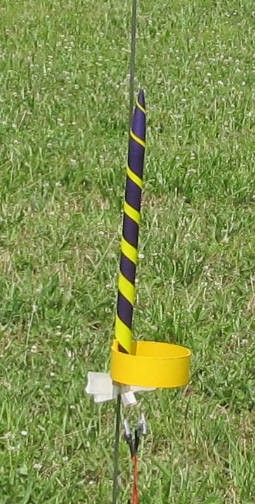
Actually delay at 4 seconds was pretty good, had a good corkscrew up to about 100 feet, and a nice recovery about 75 feet from pad.

Recovery
As mentioned, the ONLY negative I have on this kit is the streamer. And even though it tore on first flight, this model is so light that nose-blow recovery would probably be sufficient. Given however it is a small model, a brightly colored streamer is helpful not just in slowing recovery but also FINDING the rocket on the ground.
Summary
I am still giving this rocket a 5. The design is cool, the instructions and the kit (particularly the Reinforcement Plate and two launch lugs) make this a cinch to put together, probably while a bit more complicated than 3 fins and a nose cone, actually much EASIER to actually build as the guide on the Reinforcement Plate, when properly used, allow the parts to mate up perfectly. While I am generally not a fan of "cute", this rocket really is a cute little bird and it is hard not to like it just looking at it on the shelf. The CorkScrew flight pattern is fun to watch, and on the smaller engine (I think the 1/2A3-4T is a good choice, keeps it in sight, allows you to see the spiral, and recovers easily) gives a nice entertaining flight.
Sponsored Ads
 |
 |
